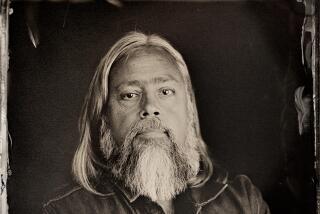Remaining Maine Micmacs Rejoice in New Status as American Indians : Tribe: A new law opens federal benefits to people in need of medical care and other aid. They were left out of an earlier regional settlement.
- Share via
MAPLETON, Me. — For the 570 members of Maine’s forgotten tribe, the Micmacs, these are days for dreaming. Their nearly 12-year-old fight for federal recognition is behind them; a potentially better life lies ahead.
Mary Sanipass, a master of the Micmac art of weaving baskets from strips of wood, envisions building a community center to preserve the culture and help to revive their native language.
Benjamin Labobe, whose parents were drunk much of his childhood, said he hopes something can be done to combat alcoholism among Micmacs.
Richard Silliboy, who spent much of his life working at “stoop labor” such as digging potatoes, wants to see the Micmacs create jobs for themselves and build new houses for tribe members who live in shacks.
In November, President Bush signed a bill, pushed by the Maine congressional delegation, recognizing the Micmacs as an American Indian tribe.
The Micmacs had fought for government recognition since 1980, when they were left out of the $81.5-million Maine Indian Claims Settlement Act. That settlement gave federal services and money for land and jobs to the state’s three other tribes--the Passamaquoddys, Penobscots and Maliseets.
“This kind of lifts you up and, it’s like, ‘Hey, I’m not left out anymore,’ ” said Mary Archer, a Micmac jewelry and leather artisan. “It makes you feel proud. It’s good for your soul and your mind.”
Besides the intangible benefits, federal recognition makes members of the Micmac tribe in Maine eligible for a range of federal programs for Indians, including medical care, housing assistance and education.
The bill Bush signed into law also will provide the Micmacs with $900,000 next October to be used to buy land for the tribe, whose U.S. members are concentrated in northern Maine’s Aroostook County.
“There’s a lot of dreams and ideas that people have had,” says Mary Philbrook, president of the Aroostook Micmac Council.
“One lady who called said what it means to her is a pair of good glasses. What it means to another man is he can get his teeth fixed and get a doctor’s care. Every individual has their own special want that hasn’t been met.”
More than 14,000 Micmacs live in North America, most in eastern Canada. Before the first European colonists arrived, Micmacs lived a nomadic life as hunters and gatherers, moving throughout the region that today is Maine and Canada’s Maritime provinces.
The tribe’s name is believed by some Micmacs to have come from the phrase they used to greet other Indians-- nicmaq, which meant “my kind friends.”
After the Revolutionary War, the Micmacs continued their traditional seasonal migrations across what had become the U.S.-Canadian border.
In the 1800s and 1900s, however, many Micmacs settled in Maine, drawn to jobs as lumberjacks, river drivers and laborers on potato farms.
But the Micmacs were left out of the 1980 land claims settlement in large part because of their nomadic ways. They hadn’t proven to the federal bureaucracy’s satisfaction that their aboriginal lands included part of what now is Maine.
“There was anger and the feeling of betrayal,” recalls Silliboy, the Aroostook Micmac Council’s program director.
To campaign for recognition and try to hold the tribe together in Maine, several Micmacs formed the council in 1982. Now, the council is shifting its focus to become the Micmacs’ link with the federal bureaucracy and needed programs.
Philbrook says the council will draw up a budget for the next fiscal year and apply for money to provide medical care and other services to tribe members.
Once the services start flowing, the Micmacs must decide how they want to spend the $900,000 they’ll receive for land.
Ideas abound, and Philbrook hopes some of the money will be invested in projects that create jobs for tribe members.
Some members dream of setting up a sporting camp with a lodge, where the Micmacs would work as guides, taking tourists canoeing, hunting and fishing. The lodge could include a store that sold Micmac crafts.
There also has been talk of starting a rehabilitation center for drug and alcohol abuse that would be open to the public, but whose primary mission would be to serve Indians, Philbrook says.
Labobe would like to see that idea pursued because of what alcohol did to his parents. He remembers a childhood moving around the state as his parents worked at migrant jobs harvesting blueberries and potatoes.
“I first remember us living in a little shack with a dirt floor and a tin roof,” recalls Labobe, 45, one of eight children. “As a kid, I didn’t go to school too much. When I did go to school, I was always dirty because my parents drank so much. You couldn’t learn that way.”
Like alcoholism, poverty persists today among tribe members in Maine. Many Micmacs are unemployed, and live on less than $10,000 a year, often in substandard housing.
Mary and Donald Sanipass, for instance, live in what once was a lumber camp shack at the edge of woods outside of Mapleton, a town of 1,800 near the Canadian border.
They have expanded the cabin to four rooms and drilled a well to provide running water inside. But they still have no indoor toilet.
Mary Sanipass, 56, hopes federal recognition will bring money to help them build a new home.
But more importantly, she wants to see some of the money used for a community center that will keep the Micmacs together and their culture alive.
“I’d like to see all our people unite,” she says. “We have to teach the children about their culture and heritage.”
Mary still speaks the Micmac language, but says it is a dying tongue because few children have learned it. She and her husband also are masters at the Micmac art of baskadegan --weaving baskets from wood--and are passing that heritage to their four children.
The Micmacs first began making baskets from strips, or “splints,” of wood in the 1700s to sell to European settlers.
The Sanipasses learned how to make baskets by watching their parents and grandparents. And, like their forefathers, they picked up the craft out of economic necessity, selling baskets to farmers for use in harvesting potatoes.
More to Read
Sign up for Essential California
The most important California stories and recommendations in your inbox every morning.
You may occasionally receive promotional content from the Los Angeles Times.













